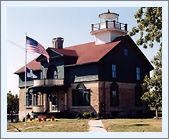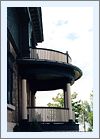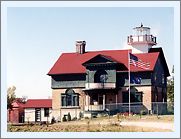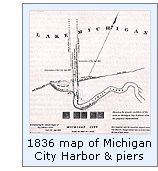| Michigan City Old Lighthouse | Seeing The Light |
|
| Michigan City, Indiana | Home | webbot bot="HTMLMarkup" startspan Backwebbot bot="HTMLMarkup" endspan |
|
|  |  |  | | Click thumbnails to view enlarged images | Historical Information

At the dawn of the third decade of the nineteenth century, Crawfordsville visionary Major Isaac C. Elston visited Indiana's small sliver of frontage on Lake Michigan, and foreseeing the potential the area represented as a shipping point for Indiana's bounty, purchased most of the land and platted the town of Michigan City on the banks of Trail Creek. Nestled between twin sand dunes known as Yankee Slide and Hoosier Slides, shifting sands from the two huge dunes blew into the river mouth, barring entry to all but vessels of the shallowest draft. Thus, vessels arriving at the river mouth were forced to anchor offshore, with their cargoes transferred to and from the waiting vessels by shallow draft scows known as lighters. By 1834, the village had grown to include a tannery, blacksmith shop, tinsmith, brick kiln, four grocery stores, three taverns five general stores, two hotels, a bank and an Episcopalian church. Seeking federal assistance in opening up the river to an increasing number of vessels, Elston solicited the assistance of Indiana Senator John Tipton, who presented a motion before the Senate on January 2, 1834 requesting funding for establishing a port of delivery and a lighthouse at the river mouth. Seeking additional input on the matter, the matter was forwarded to the Committee of Commerce for further evaluation and recommendation. Convinced of the validity of his requested improvements, and as an incentive to the Government to move on Tipton's proposal before the Senate, Elston shrewdly deeded a tract of land from the first bend of the river to the lakeshore to the Federal Government on June 23, 1835 to serve as a site for the erection of the new lighthouse for which he was convinced an appropriation would be forthcoming. 
|